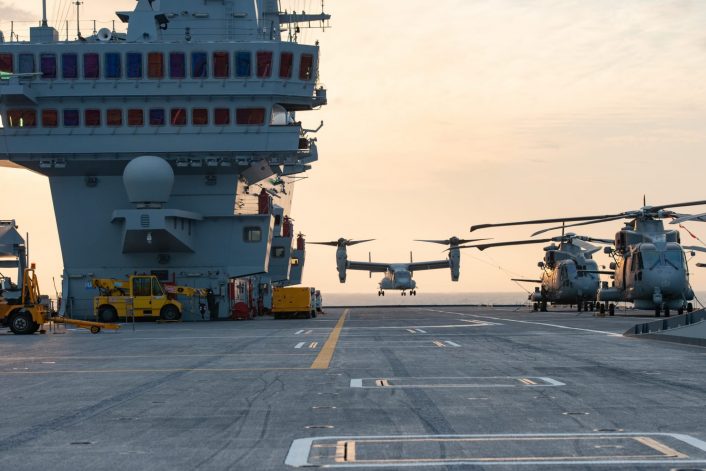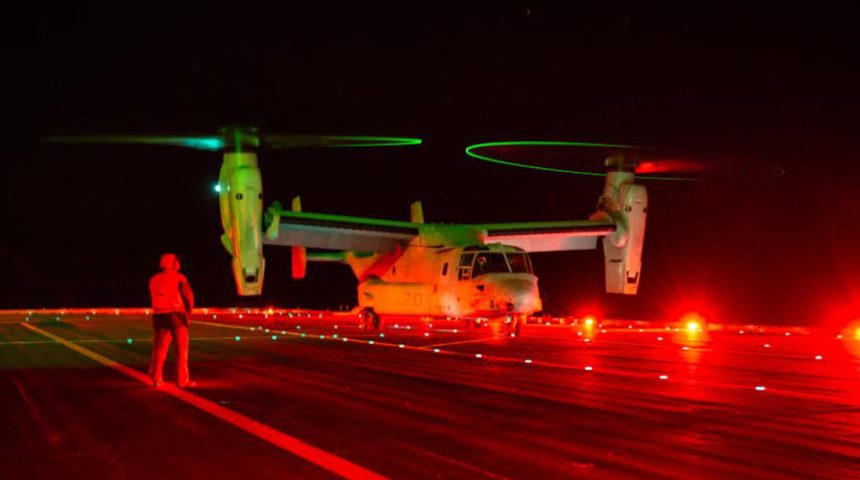After completing the Sea Trials with the U.S. Marine Corps F-35B, the aircraft carrier Cavour conducted training with a USMC MV-22B Osprey.
As already reported, the Italian Navy has recently declared the successful completion of the “sea trials” for the operational use of the F-35B, the STOVL (Short Take Off Vertical Landing) variant of the Joint Strike Fighter that will replace the service’s AV-8B+ Harrier II jet.
The “Ready for Operation” campaign included various compatibility tests carried out with two specially-instrumented U.S. F-35Bs belonging to VX-23 (Air Test and Evaluation Squadron 23) from Naval Air Station Patuxent River (NAS Pax River), Maryland. The “sea trials” lasted four weeks and ended on Mar. 26, 2021, with the return of the carrier to Norfolk.
Interestingly, the Italian Navy’s flagship was also involved in take-off and landing training with a U.S. Marine Corps MV-22B Osprey tilt-rotor aircraft.
Concluding the Sea Trials for the certification of the new #F35B #JointStrikeFighter Program, the aircraft carrier #Cavour conducts take-off and landing training with a @USMC MV-22B Osprey.@theF35JPO @USNavy pic.twitter.com/QbX8pp8DfW
— Marina Militare (@ItalianNavy) April 12, 2021
The purpose of the activity was to verify the compatibility of the flight deck with the American tactical transport aircraft.
#USMC MV-22B Osprey pilots conduct night deck landing qualifications aboard the @ItalianNavy aircraft carrier #Cavour, off the Maryland coast. @US2ndFleet. pic.twitter.com/GpYVqC6Mly
— U.S. Marines (@USMC) April 12, 2021
Back in 2015, Boeing considered the Italian Navy among the possible export customers for their V-22 platform, considered its ability to carry the F-35’s Pratt & Whitney F135 turbofan in its cargo bay (a capability required to support blue waters engine replacement) and to operate from the flight deck of the current and future aircraft carriers, including the new LHD Trieste.
While the interest in the Osprey has probably cooled now, the interoperability between the platform and the Italian Navy’s flagship is needed to “increase interoperability between the USMC and the Italian Navy, and increase the operational reach of Naval forces for crisis or contingency response or in the event of conflict.”
Moreover, Italy has shown interest in the U.S. Future Vertical Lift helicopter initiative, that sees the Bell V-280 Valor tilt-rotor aircraft, developed by Bell and Lockheed Martin, among the contenders. Tilt-rotor designs are also being developed as part of the unmanned V-247 Vigilant tiltrotor concept for the US Marine Corps (USMC) and might be considered for the US Navy’s (USN’s) Future Vertical Lift (FVL) Maritime Strike programme: this means that interoperability tests with tilt-rotors make perfect sense for the Italian Navy and ITS Cavour to prepare the future at-sea operations.

After completing the “Sea Trials”, the ITS Cavour will carry out carrier qualification of the six Italian Naval Aviators that completed their transition on the F-35B at Marine Corps Air Station (MCAS) Beaufort, South Carolina, and then head back to Italy, where the Italian Navy is planning to perform the first flight activities with an Italian F-35B from the Cavour. The aircraft that should be used will be the fourth F-35B built in Italy and the third to be delivered to the Navy. As we mentioned in previous articles, the first two aircraft built went to the Navy and are now in Beaufort for pilot training, while the third one was delivered to the Air Force. Italy has plans to procure a total of 90 F-35s for the Italian Air Force and Navy: 60 F-35As and 30 F-35Bs (15 for the Marina Militare and 15 for the Aeronautica Militare).









